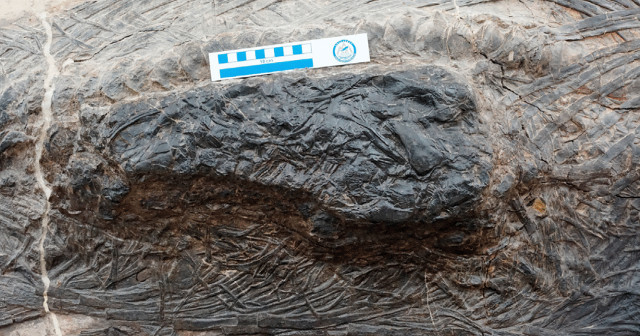
An article published in the journal “Science” reports the study of the fossil remains of an ichthyosaur whose almost complete skeleton includes some sort of extras in the form of the fossil remains of another reptile, a thalattosaur of the species Xinpusaurus xingyiensis, in its stomach. A team of researchers examined these fossils discovered in China and dating back to the Triassic period attributing them to a Guizhouichthyosaurus tangae, a species belonging to the group of ichthyosaurs. There are arguments among paleontologists that they could be apex predators in their ecosystems, and the fact that an ichthyosaur devoured an animal as large as a thalattosaur is considered evidence that at least that species was indeed an apex predator.
Ichthyosaurs were marine reptiles widespread in the Mesozoic thanks to a diversification into many species. They were well adapted to marine life, to the point of looking like fish and cetaceans. The various species were of different sizes, and paleontologists have long argued about which species were apex predators, thus at the top of the food chain in their ecosystem. Guizhouichthyosaurus tangae was a species with a length generally between 4 and 6 meters not very large in size, therefore it wasn’t considered an apex predator. However, the examination of a nearly 5-meter-long specimen discovered in 2010 in the Falang Formation in China could change that idea.
The Guizhouichthyosaurus tangae specimen discovered in 2010 was almost complete, but above all in its stomach, it contained the middle section and part of the legs of a thalattosaur whose tail was discovered meters away. There’s no certainty that the ichthyosaur killed the thalattosaur after hunting it, and it’s possible that it found a dead animal and ate it. However, in that case, the researchers would expect to find a limbless body because limbs would be the first to detach during decomposition.
The top image (Courtesy Da-Yong Jiang, et al.) shows a photo of the stomach area of Guizhouichthyosaurus tangae. The bottom image (Courtesy Da-Yong Jiang, et al.) shows another photo of the fossil along with drawings of the ichthyosaur and the thalactosaur of that was eaten.
 It’s the first time that a reptile the size of a Xinpusaurus xingyiensis was found in the stomach of a predator dating back to the era of dinosaurs. Paleontologists believed they were predators based on the shape of their jaws and teeth, but there’s now direct evidence.
It’s the first time that a reptile the size of a Xinpusaurus xingyiensis was found in the stomach of a predator dating back to the era of dinosaurs. Paleontologists believed they were predators based on the shape of their jaws and teeth, but there’s now direct evidence.
Today, very diverse animals such as orcas, crocodiles, and leopards use similar hunting techniques that were probably used millions of years ago by Guizhouichthyosaurus tangae. They’re all animals that use their teeth to grab their prey, sometimes breaking their spine with the force of their bite and then tearing them apart. The ichthyosaur subject of this study ate its prey almost whole, but wasn’t able to digest it since it died too.

